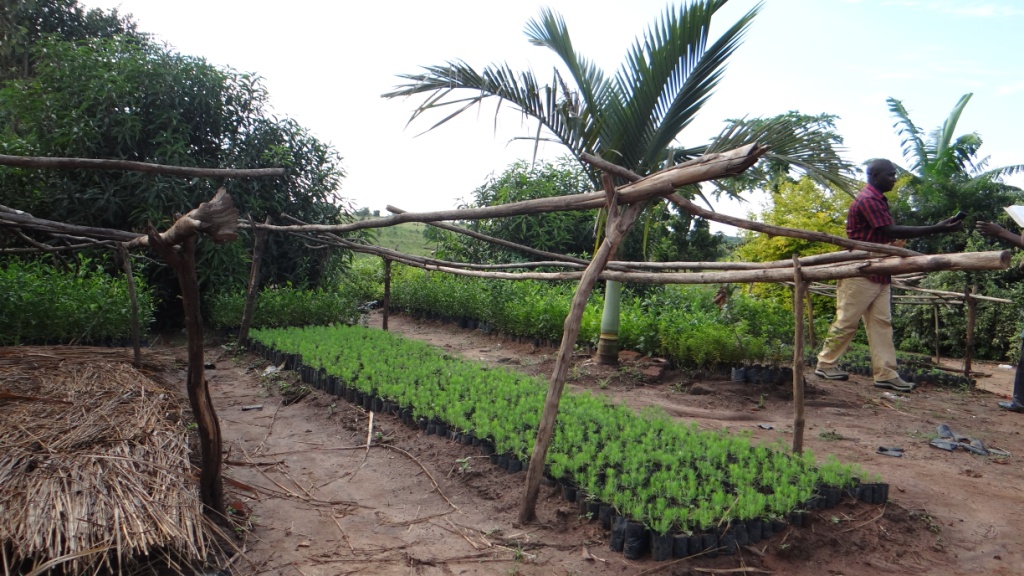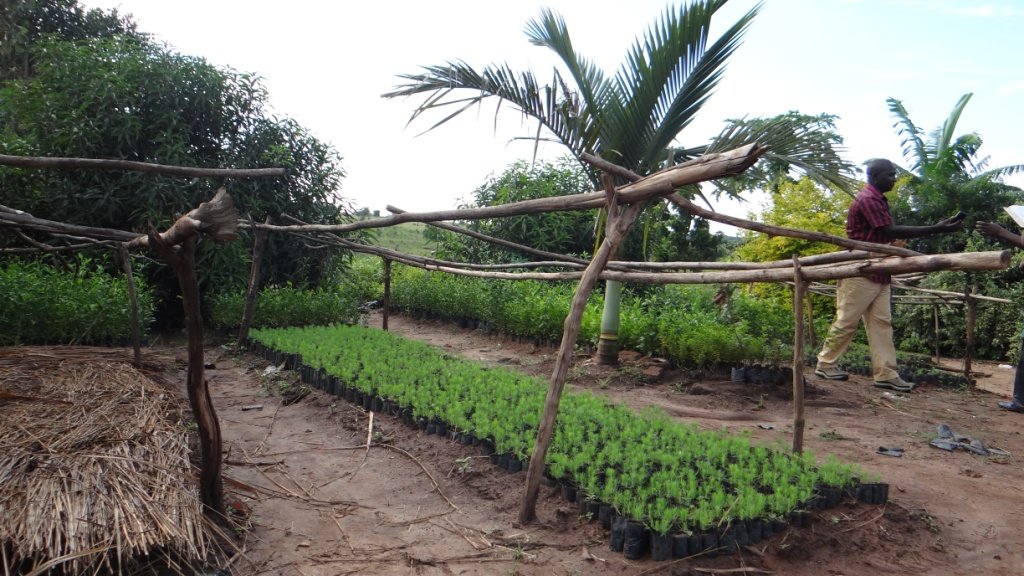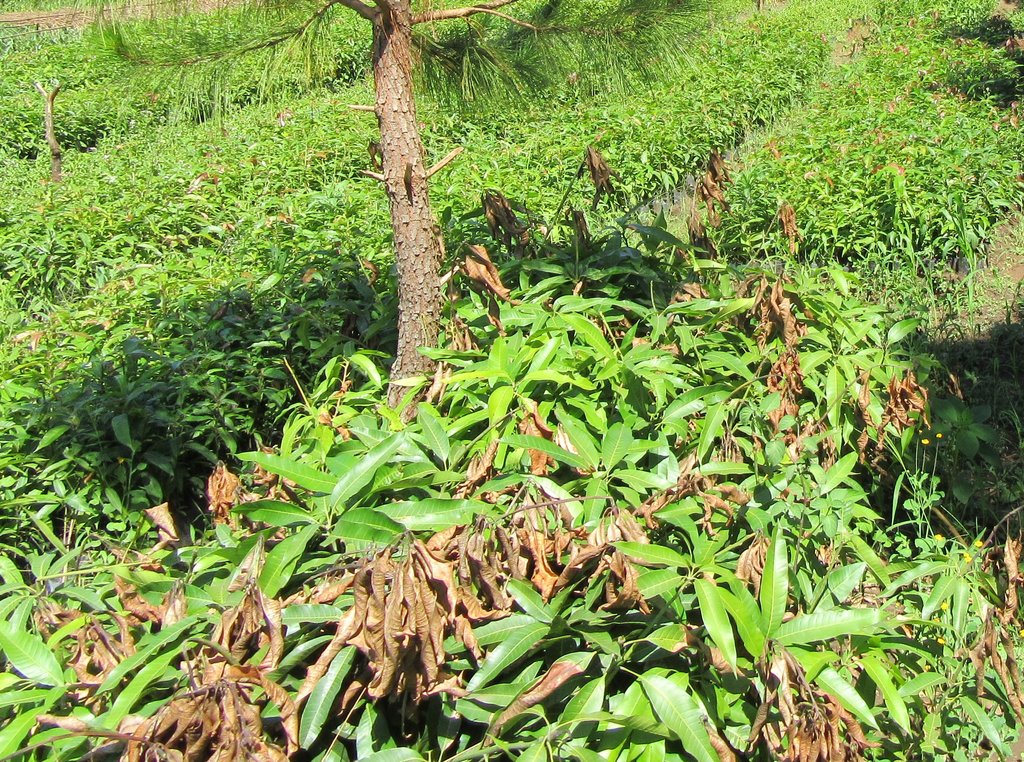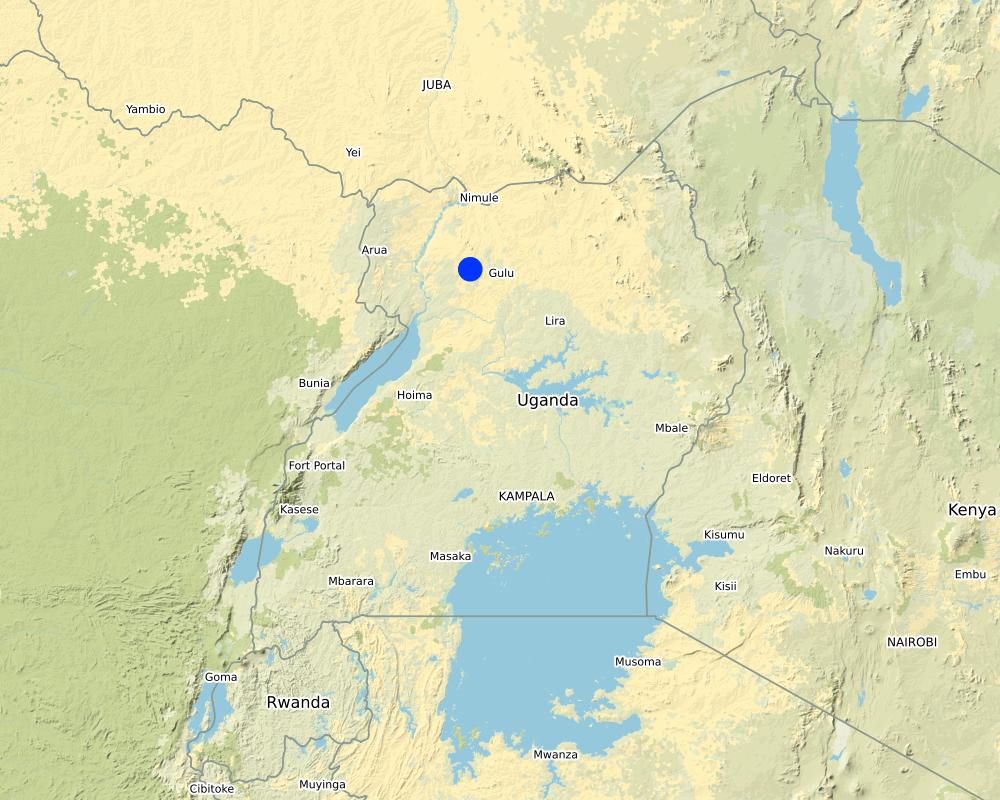Improved Tree Nursery Bed [Uganda]
- Creation:
- Update:
- Compiler: Jalia Namakula
- Editor: Kamugisha Rick Nelson
- Reviewers: Drake Mubiru, Nicole Harari, Udo Höggel
Kayubu Kodi
technologies_2797 - Uganda
View sections
Expand all Collapse all1. General information
1.2 Contact details of resource persons and institutions involved in the assessment and documentation of the Technology
Key resource person(s)
land user:
Oyet Julius
+256782165103 / +256752165103
Tudakatuba farmers group
Pajak village, Amuru District, Northern Uganda
Uganda
Name of project which facilitated the documentation/ evaluation of the Technology (if relevant)
Scaling-up SLM practices by smallholder farmers (IFAD)Name of the institution(s) which facilitated the documentation/ evaluation of the Technology (if relevant)
Uganda Landcare Network (ULN) - Uganda1.3 Conditions regarding the use of data documented through WOCAT
When were the data compiled (in the field)?
09/05/2017
The compiler and key resource person(s) accept the conditions regarding the use of data documented through WOCAT:
Yes
1.4 Declaration on sustainability of the described Technology
Is the Technology described here problematic with regard to land degradation, so that it cannot be declared a sustainable land management technology?
No
2. Description of the SLM Technology
2.1 Short description of the Technology
Definition of the Technology:
Improved fruit tree nursery is a technology comprising of grafted mangoes, grafted citrus, eucalyptus and pines, established with the aim of improving household income and promotion of agro-forestry farming systems within surrounding communities to achieve environmental conservation.
2.2 Detailed description of the Technology
Description:
Tree nurseries are places where tree seedlings are propagated, managed, and grown to a transportable size. They are essential for producing quality seedlings in high quantities for rapid afforestation and sustainable land management.
In response to promoting this technology among farmers in Uganda, the Government of Uganda, through its initiatives such as Operation Wealth Creation (OWC), is promoting the growing of high value crops such as fruit trees to improve farmers’ incomes and food security. The technology is established on a gently sloping land lying on a plot of 1725 square meters, some 300 m away from a wetland used as a source of water for the nursery during the dry season. The soils here, on observation, have high clay content and are relatively deep.
The activities for establishing the nursery involved three stages:
1. clearing the bush on site, destroying all the termite mounds, ploughing the area, and levelling the mother beds established on flat or gentle rolling area to avoid water logging during the rainy season
2. preparation of the potting area and the potting medium which was done by mixing black soil with sand and manure in a ratio of 3-1-1 respectively. These activities took 2 person days to finish, followed by potting in 5cm × 12cm potting bags, taking 10 person days. The pots were then laid in a series of 1×10m long beds with paths of 0.75m between them. This activity took 2 persons days. Seeds were planted, watered and pots were covered with grass until germination after 14 days. After germination the seedlings are left for 4 months to mature until they are ready for grafting
3. grafting the then ready root stock with desired scion. The process involves cutting the root stock and scion at an angle and fitting the two together and holding them tightly with a wide plastic thread, the grafted seedlings are then placed in beds and placed in a closed housing unit with enough humidity only to be removed after 21 days. The seedlings are now placed again in rows where they are managed until ready for transportation
Maintenance activities included spraying fortnightly with pesticides and fungicides, watering with clean water twice every week, weeding and regular sorting of the seedlings to encourage proper growth. If any shade was put it is removed when the seedlings are well established to acclimatize them to open environmental conditions before they are transplanted or sold.
The tree varieties planted include improved mangoes, citrus, clonal eucalyptus and pines. Currently the nursery has over 10,000 citrus seedlings and 15,000 mango seedlings and a few seedlings of both pine and eucalyptus.
Tree nurseries are preferred by farmers because they use small land sizes, generate a lot of income, seedlings, when planted protect the environment and help in rapid production of genetically improved fruit trees in addition to offering employment to a wide spectrum of people including unskilled and skilled persons. There are notwithstanding, challenges such as lack of reliable water source and lack of skilled labor for grafting and high nursery establishment costs.
Limited market opportunities continue to be limiting factors to the tree nursery initiatives with the government being the only big buyer of tree seedlings in North Uganda.
2.3 Photos of the Technology
2.4 Videos of the Technology
Date:
09/06/2017
Location:
Amuru District, Northern Uganda
Name of videographer:
Isa Yiga
2.5 Country/ region/ locations where the Technology has been applied and which are covered by this assessment
Country:
Uganda
Region/ State/ Province:
Northern Uganda
Further specification of location:
Pajak village, Amuru District, Northern Uganda
Comments:
Coordinates: 2.812533 and 1.96157
The Nursery beds are s located in Pajak Village, Amuru District
Map
×2.6 Date of implementation
Indicate year of implementation:
2002
2.7 Introduction of the Technology
Specify how the Technology was introduced:
- through projects/ external interventions
Comments (type of project, etc.):
This practice was lean't from a fellow farmer in Mukono District, but technical support is provided by the Amuru local government.
3. Classification of the SLM Technology
3.1 Main purpose(s) of the Technology
- improve production
- create beneficial economic impact
3.2 Current land use type(s) where the Technology is applied

Unproductive land
Specify:
Bush surrounded by former brick making area
3.3 Further information about land use
Water supply for the land on which the Technology is applied:
- mixed rainfed-irrigated
Comments:
The land user constructed a water reservoir close to a wetland to act as a water source especially during the dry season
Number of growing seasons per year:
- 1
Specify:
The trees are planted once a year
3.4 SLM group to which the Technology belongs
- tree nursery
3.5 Spread of the Technology
Specify the spread of the Technology:
- evenly spread over an area
If the Technology is evenly spread over an area, indicate approximate area covered:
- < 0.1 km2 (10 ha)
Comments:
The nursery is established on 69m2 × 25m2 of land
3.6 SLM measures comprising the Technology

vegetative measures
- V1: Tree and shrub cover
3.7 Main types of land degradation addressed by the Technology

soil erosion by water
- Wt: loss of topsoil/ surface erosion

soil erosion by wind
- Et: loss of topsoil

biological degradation
- Bc: reduction of vegetation cover
3.8 Prevention, reduction, or restoration of land degradation
Specify the goal of the Technology with regard to land degradation:
- prevent land degradation
Comments:
The nursery was established to improve production of the fruit trees and provide economic benefits to the landuser
4. Technical specifications, implementation activities, inputs, and costs
4.1 Technical drawing of the Technology
Author:
Prossy Kaheru
Date:
09/06/2017
4.2 Technical specifications/ explanations of technical drawing
The nursery is located on a 69m X 25 m (1725 m2) plot size
The nursery beds are a 1m x 10m, with a 75cm pathway between the beds
The beds contain 10,000 citrus seedlings 15,000 mango seedlings and a few clonal eucalyptus and pine trees
The pots used for growing mangoes are 5in x 7in, whereas citrus , eucalyptus and clonal are 4in X 7in
The rivets used to construct the shades are between 2m and1.5cm high. grass is used to shield the young seedlings from direct sunshine
4.3 General information regarding the calculation of inputs and costs
Specify how costs and inputs were calculated:
- per Technology area
Indicate size and area unit:
1725 m2
other/ national currency (specify):
UGX
Indicate exchange rate from USD to local currency (if relevant): 1 USD =:
3818.0
Indicate average wage cost of hired labour per day:
3000/=
4.4 Establishment activities
| Activity | Type of measure | Timing | |
|---|---|---|---|
| 1. | Determine water source | Management | June and July |
| 2. | Mix soils with manure | Agronomic | June and July |
| 3. | Buy planting material (seeds and potting bags) and poles for constructing shelter shelter | Management | June and July |
| 4. | Potting and planting seeds | Agronomic | June and July |
| 5. | Cover pots with grass | Agronomic | June and July |
| 6. | Put under shade | Management | June and July |
4.5 Costs and inputs needed for establishment
| Specify input | Unit | Quantity | Costs per Unit | Total costs per input | % of costs borne by land users | |
|---|---|---|---|---|---|---|
| Labour | Potting and Planting | People | 4.0 | 12000.0 | 48000.0 | 100.0 |
| Labour | Arranging pots | People | 1.0 | 50000.0 | 50000.0 | 100.0 |
| Labour | Preparing mango seeds | people | 4.0 | 10000.0 | 40000.0 | 100.0 |
| Labour | 100.0 | |||||
| Equipment | Water pump | Piece | 1.0 | 1000000.0 | 1000000.0 | 100.0 |
| Equipment | Wheel barrow | Piece | 2.0 | 80000.0 | 160000.0 | 100.0 |
| Equipment | Watering can | Piece | 9.0 | 7500.0 | 67500.0 | 100.0 |
| Equipment | Potting bags | Roll | 12.0 | 6000.0 | 72000.0 | 100.0 |
| Equipment | Water storage drum | Piece | 1.0 | 70000.0 | 70000.0 | 100.0 |
| Plant material | Seeds (Eucalyptus) | Kg | 5.0 | 30000.0 | 150000.0 | 100.0 |
| Plant material | Seeds (Pine) | Kg | 10.0 | 10000.0 | 100000.0 | 100.0 |
| Plant material | Seeds (citrus) | Kg | 4.0 | 60000.0 | 240000.0 | 100.0 |
| Plant material | Seeds (mangoes) | Bag | 50.0 | 15000.0 | 750000.0 | 100.0 |
| Plant material | Cyons (mangoes) | Piece | 15000.0 | 100.0 | 1500000.0 | 100.0 |
| Plant material | Cyons (citrus) | Piece | 10000.0 | 20.0 | 200000.0 | 100.0 |
| Plant material | Soil | Truck | 2.0 | 50000.0 | 100000.0 | 100.0 |
| Plant material | Sand | Truck | 1.0 | 50000.0 | 50000.0 | 100.0 |
| Fertilizers and biocides | DAP | Kg | 5.0 | 3500.0 | 17500.0 | 100.0 |
| Fertilizers and biocides | Liquid fertilisers | Litre | 1.0 | 18000.0 | 18000.0 | 100.0 |
| Construction material | Construction poles | piece | 50.0 | 3000.0 | 150000.0 | 100.0 |
| Construction material | Grass | piece | 50.0 | 2500.0 | 125000.0 | 100.0 |
| Construction material | Nails | kg | 3.0 | 1000.0 | 3000.0 | 100.0 |
| Construction material | Polythene bags (6inch) | kg | 100.0 | 6500.0 | 650000.0 | 100.0 |
| Construction material | Polythene bags | kg | 120.0 | 6500.0 | 780000.0 | 100.0 |
| Total costs for establishment of the Technology | 6341000.0 | |||||
Comments:
The land user takes this as a major source of income
4.6 Maintenance/ recurrent activities
| Activity | Type of measure | Timing/ frequency | |
|---|---|---|---|
| 1. | Watering | Agronomic | 2/week |
| 2. | Pesticides application | Agronomic | 2/season |
| 3. | Sorting of seedlings | Agronomic | 2/season |
| 4. | Construction of shades | Structural | 1/season |
Comments:
Sorting of seedlings happens continuously every season
4.7 Costs and inputs needed for maintenance/ recurrent activities (per year)
| Specify input | Unit | Quantity | Costs per Unit | Total costs per input | % of costs borne by land users | |
|---|---|---|---|---|---|---|
| Labour | Watering | People | 5.0 | 3000.0 | 15000.0 | 100.0 |
| Labour | Weeding | People | 5.0 | 15000.0 | 75000.0 | 100.0 |
| Labour | Sorting | People | 5.0 | 1000.0 | 5000.0 | 100.0 |
| Labour | Strings | People | 2.0 | 8000.0 | 16000.0 | 100.0 |
| Construction material | Poles | Piece | 50.0 | 1500.0 | 75000.0 | 100.0 |
| Construction material | Grass | Bundle | 25.0 | 2500.0 | 62500.0 | 100.0 |
| Total costs for maintenance of the Technology | 248500.0 | |||||
4.8 Most important factors affecting the costs
Describe the most determinate factors affecting the costs:
Accessibility to quality seed, transportation of materials, drought
5. Natural and human environment
5.1 Climate
Annual rainfall
- < 250 mm
- 251-500 mm
- 501-750 mm
- 751-1,000 mm
- 1,001-1,500 mm
- 1,501-2,000 mm
- 2,001-3,000 mm
- 3,001-4,000 mm
- > 4,000 mm
Specifications/ comments on rainfall:
Rainfall started late. First season rains started in April instead of late March, and second season started in September instead of late August
Indicate the name of the reference meteorological station considered:
Gulu meteorology station
Agro-climatic zone
- humid
5.2 Topography
Slopes on average:
- flat (0-2%)
- gentle (3-5%)
- moderate (6-10%)
- rolling (11-15%)
- hilly (16-30%)
- steep (31-60%)
- very steep (>60%)
Landforms:
- plateau/plains
- ridges
- mountain slopes
- hill slopes
- footslopes
- valley floors
Altitudinal zone:
- 0-100 m a.s.l.
- 101-500 m a.s.l.
- 501-1,000 m a.s.l.
- 1,001-1,500 m a.s.l.
- 1,501-2,000 m a.s.l.
- 2,001-2,500 m a.s.l.
- 2,501-3,000 m a.s.l.
- 3,001-4,000 m a.s.l.
- > 4,000 m a.s.l.
Indicate if the Technology is specifically applied in:
- not relevant
5.3 Soils
Soil depth on average:
- very shallow (0-20 cm)
- shallow (21-50 cm)
- moderately deep (51-80 cm)
- deep (81-120 cm)
- very deep (> 120 cm)
Soil texture (topsoil):
- medium (loamy, silty)
Soil texture (> 20 cm below surface):
- fine/ heavy (clay)
5.4 Water availability and quality
Ground water table:
< 5 m
Availability of surface water:
good
Water quality (untreated):
good drinking water
Is water salinity a problem?
No
Is flooding of the area occurring?
No
Comments and further specifications on water quality and quantity:
The nursery borders with a wetland therefore, water availability is not a challenge
5.5 Biodiversity
Species diversity:
- medium
Habitat diversity:
- low
Comments and further specifications on biodiversity:
Only a few tree species planted
5.6 Characteristics of land users applying the Technology
Sedentary or nomadic:
- Sedentary
Market orientation of production system:
- commercial/ market
Off-farm income:
- less than 10% of all income
Relative level of wealth:
- rich
Individuals or groups:
- individual/ household
Level of mechanization:
- mechanized/ motorized
Gender:
- men
Age of land users:
- middle-aged
Indicate other relevant characteristics of the land users:
The nursery owner also operates a small maize mill
5.7 Average area of land owned or leased by land users applying the Technology
- < 0.5 ha
- 0.5-1 ha
- 1-2 ha
- 2-5 ha
- 5-15 ha
- 15-50 ha
- 50-100 ha
- 100-500 ha
- 500-1,000 ha
- 1,000-10,000 ha
- > 10,000 ha
Is this considered small-, medium- or large-scale (referring to local context)?
- small-scale
Comments:
The technology lies on less than an acre of land. The average land holding of this area is 2ha.
5.8 Land ownership, land use rights, and water use rights
Land ownership:
- communal/ village
Land use rights:
- communal (organized)
Water use rights:
- communal (organized)
5.9 Access to services and infrastructure
health:
- poor
- moderate
- good
education:
- poor
- moderate
- good
technical assistance:
- poor
- moderate
- good
employment (e.g. off-farm):
- poor
- moderate
- good
markets:
- poor
- moderate
- good
energy:
- poor
- moderate
- good
roads and transport:
- poor
- moderate
- good
drinking water and sanitation:
- poor
- moderate
- good
financial services:
- poor
- moderate
- good
6. Impacts and concluding statements
6.1 On-site impacts the Technology has shown
Socio-economic impacts
Income and costs
farm income
Comments/ specify:
The farmer sold 25,000 seedlings and earned over UGX 37,500,000 ( USD 9,868)
Ecological impacts
Soil
soil moisture
Comments/ specify:
continuous watering of the seedlings, maintains soil moisture
6.2 Off-site impacts the Technology has shown
water availability
Comments/ specify:
The water used in the dry season is drawn from the pond constructed in a wetland close. However this is affecting the water flow to other neighbours using this water.
6.3 Exposure and sensitivity of the Technology to gradual climate change and climate-related extremes/ disasters (as perceived by land users)
Gradual climate change
Gradual climate change
| Season | Type of climatic change/ extreme | How does the Technology cope with it? | |
|---|---|---|---|
| annual temperature | increase | well | |
| annual rainfall | decrease | well |
6.4 Cost-benefit analysis
How do the benefits compare with the establishment costs (from land users’ perspective)?
Short-term returns:
negative
Long-term returns:
positive
How do the benefits compare with the maintenance/ recurrent costs (from land users' perspective)?
Short-term returns:
positive
Long-term returns:
very positive
Comments:
Tree nurseries are very expensive to establish and take close to a year for the seedlings to be sold. Therefore, establishment costs surpass benefits in the short run, however when the trees are sold they fetch a lot of income. Maintenance costs, both in the short and long term are positve.
6.5 Adoption of the Technology
- 1-10%
Of all those who have adopted the Technology, how many have did so spontaneously, i.e. without receiving any material incentives/ payments?
- 90-100%
6.6 Adaptation
Has the Technology been modified recently to adapt to changing conditions?
No
6.7 Strengths/ advantages/ opportunities of the Technology
| Strengths/ advantages/ opportunities in the land user’s view |
|---|
| Optimal space utilisation |
| Maintenance costs are low |
| Nurseries generate high value crops |
| Strengths/ advantages/ opportunities in the compiler’s or other key resource person’s view |
|---|
| Nurseries rehabilitate degraded land |
| Environmental improvements |
| They are used for aesthetic benefits |
6.8 Weaknesses/ disadvantages/ risks of the Technology and ways of overcoming them
| Weaknesses/ disadvantages/ risks in the land user’s view | How can they be overcome? |
|---|---|
| Establishment costs are high | Bulk purchases of inputs |
| Grafting needs technical skills | Hire skilled labour |
| Markets are inaccessible | Register company with the district and sub-county |
| Weaknesses/ disadvantages/ risks in the compiler’s or other key resource person’s view | How can they be overcome? |
|---|---|
| Labour intensive | |
| Markets are highly seasonal | Sourcing from other buyers for examples NGOs promoting agro- forestry |
| Trees do not grow at the same rate | Application of fertilizers |
7. References and links
7.1 Methods/ sources of information
- field visits, field surveys
one
- interviews with land users
one
7.2 References to available publications
Title, author, year, ISBN:
Improving Sustainable Productivity in Farming systems and Enhanced livelihoods through Adoption of Evergreen Agriculture in Eastern Africa. Joy Buyinza and Vicent I Opolot
Available from where? Costs?
https://www.cgiar.org/research/publication/improving-sustainable-productivity-in-farming-systems-and-enhanced-livelihoods-through-adoption-of-evergreen-agriculture-in-eastern-africa-shortened-as-trees-for-food-security-project/
7.3 Links to relevant information which is available online
Title/ description:
Improving Sustainable Productivity in Farming systems and Enhanced livelihoods through Adoption of evergreen Agriculture in Eastern Africa
URL:
https://www.worldagroforestry.org
Links and modules
Expand all Collapse allLinks
No links
Modules
No modules





